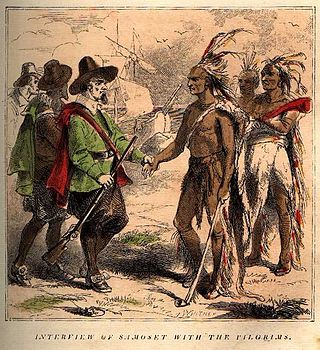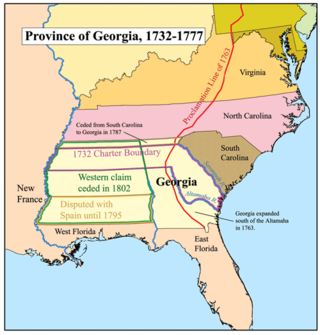
The Thirteen Colonies, also known as the Thirteen British Colonies or the Thirteen American Colonies, were a group of British colonies on the Atlantic coast of North America founded in the 17th and 18th centuries. The American Enlightenment led these colonies to the American Revolutionary War, declaring independence in July 1776, which was achieved by 1783 under the Treaty of Paris.

The Colony of Virginia, originally chartered in 1584 and established in 1585, the colony lasted for 3 attempts totaling 6 years. In 1590 the colony was abandoned. But nearly 20 years later, the colony relocated not far North of the original site. The 2nd charter was issued in 1606 and settled in 1607, was the first enduring English colony in North America. It followed failed attempts at settlement on Newfoundland by Sir Humphrey Gilbert in 1583 and the Roanoke Colony by Sir Walter Raleigh in the late 1580s.

Slavery in the colonial history of the United States, from 1526 to 1776, developed from complex factors, and researchers have proposed several theories to explain the development of the institution of slavery and of the slave trade. Slavery strongly correlated with the European colonies' demand for labor, especially for the labor-intensive plantation economies of the sugar colonies in the Caribbean and South America, operated by Great Britain, France, Spain, Portugal, and the Dutch Republic.

The colonial history of the United States covers the history of European colonization of North America from the early 17th century until the incorporation of the Thirteen Colonies into the United States after the Revolutionary War. In the late 16th century, England, Kingdom of France, Spanish Empire, and the Dutch Republic launched major colonization programs in North America. The death rate was very high among early immigrants, and some early attempts disappeared altogether, such as the English Lost Colony of Roanoke. Nevertheless, successful colonies were established within several decades.

John Rolfe was an English explorer, farmer and merchant. He is best known for being the husband of Pocahontas and the first settler in the colony of Virginia to successfully cultivate a tobacco crop for export.

The Southern Colonies within British America consisted of the Province of Maryland, the Colony of Virginia, the Province of Carolina, and the Province of Georgia. In 1763, the newly created colonies of East Florida and West Florida would be added to the Southern Colonies by Great Britain until the Spanish Empire took back Florida. These colonies were the historical core of what would become the Southern United States, or "Dixie". They were located south of the Middle Colonies, albeit Virginia and Maryland were also considered as the Chesapeake Colonies.

The Province of Maryland was an English and later British colony in North America that existed from 1632 until 1776, when it joined the other twelve of the Thirteen Colonies in rebellion against Great Britain and became the U.S. state of Maryland. Its first settlement and capital was St. Mary's City, in the southern end of St. Mary's County, which is a peninsula in the Chesapeake Bay and is also bordered by four tidal rivers.
A plantation economy is an economy based on agricultural mass production, usually of a few commodity crops, grown on large farms worked by laborers or slaves. The properties are called plantations. Plantation economies rely on the export of cash crops as a source of income. Prominent crops included cotton, rubber, sugar cane, tobacco, figs, rice, kapok, sisal, and species in the genus Indigofera, used to produce indigo dye.

In the history of the Southern United States, the Antebellum Period spanned the end of the War of 1812 to the start of the American Civil War in 1861. The Antebellum South was characterized by the use of slavery and the culture it fostered. As the era proceeded, Southern intellectuals and leaders gradually shifted from portraying slavery as an embarrassing and temporary system, to a defense of slavery as a positive good, and harshly criticized the nascent abolitionist movement.
A headright refers to a legal grant of land given to settlers during the period of European colonization in the Americas. A "headright" includes both the grant of land and the owner that claims the land. The person who has a right to the land is the one who paid to transport people to a colony. Headrights are most notable for their role in the expansion of the Thirteen Colonies; the Virginia Company gave headrights to settlers, and the Plymouth Company followed suit. The headright system was used in several colonies, including Maryland, Georgia, North Carolina and South Carolina. Most headrights were for 1 to 1,000 acres (4.0 km2) of land, and were granted to those who were willing to cross the Atlantic and help populate the colonies. Headrights were granted to anyone who would pay for the transportation costs of an indentured laborer. These land grants consisted of 50 acres (0.20 km2) for someone newly moving to the area and 100 acres (0.40 km2) for people previously living in the area. By ensuring the landowning masters had legal ownership of all land acquired, the indentured laborers after their indenture period had passed had little opportunity to procure their own land. This kept a large portion of the citizens of the Thirteen Colonies poor and led to tensions between the laborers and the landowners.

The Chesapeake Colonies were the Colony and Dominion of Virginia, later the Commonwealth of Virginia, and Province of Maryland, later Maryland, both colonies located in British America and centered on the Chesapeake Bay. Settlements of the Chesapeake region grew slowly due to diseases such as malaria. Most of these settlers were male immigrants from England who died soon after their arrival. Due to the majority of men, eligible women did not remain single for long. The native-born population eventually became immune to the Chesapeake diseases and these colonies were able to continue through all the hardships.

Tobacco and Slaves: The Development of Southern Cultures in the Chesapeake, 1680–1800, is a book written by historian Allan Kulikoff. Published in 1986, it is the first major study that synthesized the historiography of the colonial Chesapeake region of the United States. Tobacco and Slaves is a neo-Marxist study that explains the creation of a racial caste system in the tobacco-growing regions of Maryland and Virginia and the origins of southern slave society. Kulikoff uses statistics compiled from colonial court and church records, tobacco sales, and land surveys to conclude that economic, political, and social developments in the 18th-century Chesapeake established the foundations of economics, politics, and society in the 19th-century South.

The history of commercial tobacco production in the United States dates back to the 17th century when the first commercial crop was planted. The industry originated in the production of tobacco for pipes and snuff. Different war efforts in the world created a shift in demand and production of tobacco in the world and the American colonies. With the onset of the American Revolution trade with the colonies was interrupted which shifted trade to other countries in the world. During this shift there was an increase in demand for tobacco in the United States, where the demand for tobacco in the form of cigars and chewing tobacco increased. Other wars, such as the War of 1812 would introduce the Andalusian cigarette to the rest of Europe. This, accompanied with the American Civil War changed the production of tobacco in America to the manufactured cigarette.
During the British colonization of North America, the Thirteen Colonies provided England with much needed money and resources. However, the culture of the Southern and Chesapeake Colonies was different from that of the Northern and Middle Colonies and from that of their common British colonial power.

Tobacco has a long history in the United States.

Tobacco cultivation and exports formed an essential component of the American colonial economy. During the Civil War, they were distinct from other cash crops in terms of agricultural demands, trade, slave labor, and plantation culture. Many influential American revolutionaries, including Thomas Jefferson and George Washington, owned tobacco plantations, and were financially devastated by debt to British tobacco merchants shortly before the American Revolution.

Slavery in Maryland lasted over 200 years, from its beginnings in 1642 when the first Africans were brought as slaves to St. Mary's City, to its end after the Civil War. While Maryland developed similarly to neighboring Virginia, slavery declined here as an institution earlier, and it had the largest free black population by 1860 of any state. The early settlements and population centers of the province tended to cluster around the rivers and other waterways that empty into the Chesapeake Bay. Maryland planters cultivated tobacco as the chief commodity crop, as the market for cash crops was strong in Europe. Tobacco was labor-intensive in both cultivation and processing, and planters struggled to manage workers as tobacco prices declined in the late 17th century, even as farms became larger and more efficient. At first, indentured servants from England supplied much of the necessary labor but, as their economy improved at home, fewer made passage to the colonies. Maryland colonists turned to importing indentured and enslaved Africans to satisfy the labor demand.
Culpeper's Rebellion was a popular uprising in 1677 provoked by the enforcement of the Navigation Acts. It was led by settler John Culpeper against the ruling Lords Proprietor in Albemarle County, Carolina, near what is now Elizabeth City, North Carolina. The uprising met with only limited success, but Culpeper himself was acquitted of rebellion and became a hero, and the Lords Proprietor subsequently made efforts to strengthen the colony's government.
Maryland's colonial economic history is marked by a heavy reliance on the tobacco crop. Though it would remain a slave state until the end of the Civil War, it was not until the 1700s that labor began to drive agricultural production in the colony. The colonial-era would also see Maryland begin early industrialization and urbanization, experiment with different monetary systems, and make efforts to diversify its economy.

The planter class, known alternatively in the United States as the Southern aristocracy, was a racial and socioeconomic caste of pan-American society that dominated 17th and 18th century agricultural markets. The Atlantic slave trade permitted planters access to inexpensive African slave labor for the planting and harvesting of crops such as tobacco, cotton, indigo, coffee, tea, cocoa, sugarcane, sisal, oil seeds, oil palms, hemp, rubber trees, and fruits. Planters were considered part of the American gentry.












